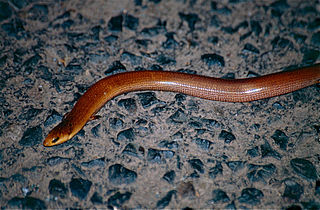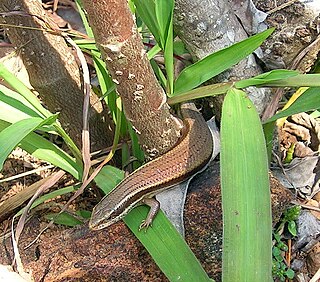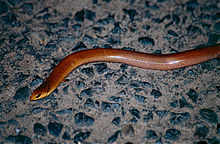
Skinks are lizards belonging to the family Scincidae, a family in the infraorder Scincomorpha. With more than 1,500 described species across 100 different taxonomic genera, the family Scincidae is one of the most diverse families of lizards. Skinks are characterized by their smaller legs in comparison to typical lizards and are found in different habitats except arctic and subarctic regions.

Cryptoblepharus is a genus of skinks, lizards in the family Scincidae. The genus contains at least 53 species.

Ophioscincus is a genus of skink known to inhabit parts of Australia.

Panaspis is a genus of skinks, commonly called lidless skinks or snake-eyed skinks, endemic to Sub-saharan Africa.

George Albert Boulenger was a Belgian-British zoologist who described and gave scientific names to over 2,000 new animal species, chiefly fish, reptiles, and amphibians. Boulenger was also an active botanist during the last 30 years of his life, especially in the study of roses.

Blue-tongued skinks comprise the Australasian genus Tiliqua, which contains some of the largest members of the skink family (Scincidae). They are commonly called blue-tongued lizards or simply blue-tongues or blueys in Australia. As suggested by these common names, a prominent characteristic of the genus is a large blue tongue that can be bared as bluff-warning to potential enemies. The type of predator/threat that is near will determine the intensity of colour present in the tongue. In addition, their blue tongue will produce a response in the prey which will in turn diminish the attack. The tongue can also deform itself and produce a thick mucus in order to catch prey. They are relatively shy in comparison with other lizards, and also significantly slower due to their shorter legs.

Threatened fauna of Australia are those species and subspecies of birds, fish, frogs, insects, mammals, molluscs, crustaceans and reptiles to be found in Australia that are in danger of becoming extinct. This list is the list proclaimed under the Australian federal Environment Protection and Biodiversity Conservation Act 1999. The classifications are based on those used by the World Conservation Union (IUCN), however IUCN and Australian rankings do differ. Each state and territory has its own legislation relating to environmental protection.

The eastern brown snake, often referred to as the common brown snake, is a species of highly venomous snake in the family Elapidae. The species is native to eastern and central Australia and southern New Guinea. It was first described by André Marie Constant Duméril, Gabriel Bibron, and Auguste Duméril in 1854. The adult eastern brown snake has a slender build and can grow to 2 m (7 ft) in length. The colour of its surface ranges from pale brown to black, while its underside is pale cream-yellow, often with orange or grey splotches. The eastern brown snake is found in most habitats except dense forests, often in farmland and on the outskirts of urban areas, as such places are populated by its main prey, the house mouse. The species is oviparous. The International Union for Conservation of Nature classifies the snake as a least-concern species, though its status in New Guinea is unclear.

The three-toed snake-tooth skink is a species of skink in the family Scincidae. It is endemic to south-eastern Queensland and north-eastern New South Wales, Australia. It occurs in subtropical rainforest, wet sclerophyll forest, and montane forest on rich dark soils on the coast and adjacent ranges; some coastal/island populations occur on pale sands in lowlands.

Lygosominae is the largest subfamily of skinks in the family Scincidae. The subfamily can be divided into a number of genus groups. If the rarely used taxonomic rank of infrafamily is employed, the genus groups would be designated as such, but such a move would require a formal description according to the ICZN standards.

Saiphos equalis, commonly known as the yellow-bellied three-toed skink or simply three-toed skink, is a species of burrowing skink found in eastern Australia. It is the only species classified under the genus Saiphos.
Malleodectes is a genus of unusual marsupial, first discovered in 2011 at Riversleigh, Queensland, Australia. It could grow as large as a ferret, and lived in the Miocene, 17 million years ago. The reason for its name, which means "Hammer Biter", is because it has blunt, hammer-like teeth, not known from any other mammal extant or extinct. However, Scott Hocknull from the Queensland Museum has noticed similarities to the modern pink-tongued skink, a reptile specialised for eating snails. This suggests that Malleodectes too was a specialised snail hunter.

Cryptoblepharus australis, commonly called the inland snake-eyed skink, is a species of skink in the genus Cryptoblepharus.
The western keeled snake is a species of snake in the family Pseudaspididae. It is native to western Namibia, southwestern Angola, and southwestern Zambia, and is the only member of the genus Pythonodipsas.

The desert egernia, unadorned desert-skink or desert skink is a species of skink, a lizard in the family Scincidae. The desert egernia is endemic to the continent of Australia, and is widespread, with populations recorded in all mainland states and territories except the Australian Capital Territory. The desert egernia is found in dry, desert areas with deep, uncompacted sandy/loamy soils and little significant vegetation cover.
The limbless snake-tooth skink is a species of skink. It is endemic to north-eastern Queensland, Australia. It is a large, fossorial skink that occurs in the rainforest of coastal ranges and lowlands.
The three-toed skink can refer to several animals, all of the family Scincidae:













